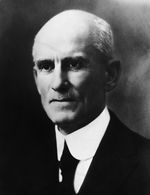El Banco Mercantil de Monterrey
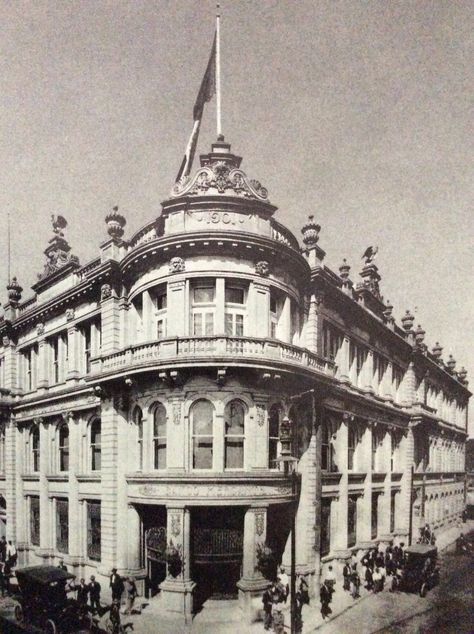
Headquarters specially constructed for the bank in 1900 at the corner of Morelos and Zaragoza
This bank opened its doors on 6 December 1899. The concession had been sought by Enrique C. Creel and Tomás Mendirichaga on 19 May 1899, granted on 27 July and approved by President Díaz on 14 October.
The bank's capital was originally $500,000 but increased in November 1899, before opening, to $2,500,000. The Presidente was Tomás Mendirichaga and other members of the first consejo de administración were Enrique C. Creel, Marcelino Garza, Lorenzo Garza Treviño, Valentín Rivero y Gajá as consejeros propietarios, and Antonio V. Hernández, Vicente Ferrara, Francisco G. Sada, Gabriel Flores and José Muguerzalisted as José Allenqueta in El Correo Español, 15 December 1899 as consejeros suplentes. The board named Antonio V. Hernández manager, Rodolfo J. García contador and Enrique Miguel cajero.
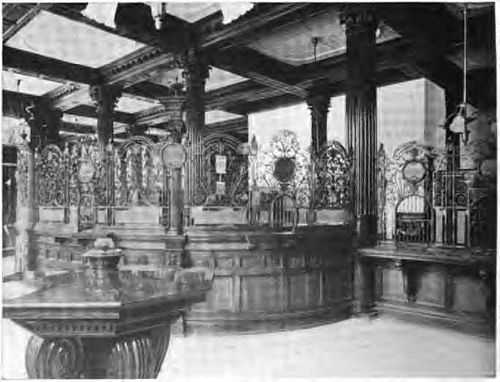
Receiving and Paying Tellers' Windows
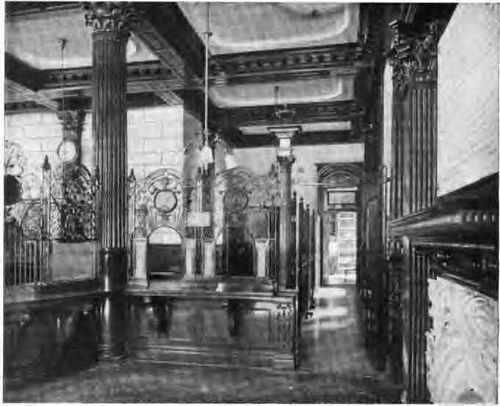
Cashier's Department and Entrance to Safe Deposit Vaults
Signatures
Gerente
|
José Antonio Víctor Hernández y Benavides was born on the hacienda of Guadalupe, San Juan Bautista del Río Grande, Coahuila, on 6 March 1845, the son of Captain Marcos Hernández Montalvo, jefe político of the Partido de Río Grande. In 1871 he married Ana María González Treviño, sister of Mercedes González Treviño (mother of Francisco I. Madero), with whom he had thirteen children. He was the brother-in-law of Evaristo Madero, who was married first to his half-sister, Rafaela Hernández Lombraña, and secondly to his first cousin, Manuela Farías Benavides (mother of Ernesto Madero Farías). His business activities concentrated on mining, agriculture and banking. In 1874 he founded the Minera San Pablo. In 1875 he joined, together with Francisco Madero Hernández, the company Madero y Cía (founded by Evaristo Madero and Lorenzo González Treviño in 1865). In 1887 he founded, together with Francisco Madero Hernández, the Madero y Hernández Sociedad Agrícola (dissolved in 1894), owner of six farms in La Laguna, one in Nuevo León, sixteen grazing sites in Coahuila, as well as other lands. In 1891 he founded the San Nicolás Mining Company on the San Nicolás Tolentino mines together with Manuel Romero Rubio, General Jerónimo Treviño, Viviano L. Villarreal, Andrés Farías Benavides, Evaristo Madero, among others. In 1894 he founded the Minera La Parreña. In 1897 he founded Minera Azteca S.A. and Minera Dolores S.A., as well as Compañía de Baños de Monterrey S.A. and the Las Mitras Brick Factory. In 1899 he appears as a shareholder of the Fábrica de Vidrios y Cristales de Monterrey S.A., both together with José A. Muguerza and Francisco G. Sada. In 1900 he founded the Minera del Norte and the Fábrica de Carton de Monterrey S.A. In 1902 he founded Minera Las Higueras S.A. and the Compañía de Aserrar Maderas de Caballeros S.A. In 1892 Hernández founded the Banco de Nuevo León, of which he was manager until 31 August 1899 when he left after certain disagreements and founded the Banco Mercantil de Monterrey, of which he was manager, shareholder and member of its board of directors. He was involved in the founding of the Banco Central Mexicano in 1899 and the Banco de Guanajuato in 1900. In 1904 he founded the Sociedad Cooperativa de Ahorros e Inversiones de Monterrey, with Andrés Farías Benavides, another brother-in-law of Evaristo Madero, as manager. From December 1882 to May 1883 Hernández served as governor of Coahuila, being preceded and succeeded by his brother-in-law Evaristo Madero. In 1901 he was appointed senator of the Federation, and held the presidency of the Senate in 1908. He died on 3 March 1926 at his home in Mexico City. He signed notes dated 1900. |
 |
|
He signed the notes dated from 1906 to 1911. |
 |
Interventor
|
Manuel G. Rivero was the bank's first Interventor. He signed the notes dated from 1900 to 1902. Rivero gave up his office in February 1901 and was followed by Bernando Reyes, hijoinforme of Interventor Bernando Reyes, hijo, 22 July 1901 Memorias de las Instituciones de Crédito correspondientes á los años 1900-1902, vol. I. Reyes himself resigned in July 1902 on moving to the capitalCEHM Fondo DLI-1 Copiadores del General Bernardo Reyes (1889-1911), 36.17586, to be replaced by C. MadrigalCEHM Fondo DLI-1 Copiadores del General Bernardo Reyes (1889-1911), 39.19336. Rivero was a Deputy six times between 1897 and 1909 and was interim governor between August and November 1902. Rivero owned the “El Porvenir” textile factory. In September 1916, its workers’ union went on strike, demanding a wage increase. Rivero refused, arguing that conditions prevented him from raising wages, since he would be at a competitive disadvantage but Pablo de la Garza’ government ruled in favour of the salary increase and Rivero had to comply. In April 1917, the same company refused to comply with the laws emanating from the 1917 Constitution relating to wage agreements, and President Carranza himself had to intervene, sending a telegram threatening to "intervene the companies" that did not want to comply with the provisions. |
 |
|
Manuel E. Gómez took over from C. Madrigal on 9 September 1903informe of Interventor Gómez, 18 January 1904 Memorias de las Instituciones de Crédito correspondientes al año 1903. He signed the notes dated from 1906 to 1911. |
 |
Presidente
|
By 1896 the company, now called Sucesores de Hernández Hnos, was one of the largest and most influential business houses in Mexico with stores in Lerdo, Monterrey and Nuevo Laredo. “They deal in dry goods, groceries, agricultural implements and all native products of the Republic. The firm also does a banking business under the same name as that under which their stores are conducted. The stores are well arranged and the shelves, show cases and warehouses are filled with all grades of goods to meet the demands of all classes of customers. Fair dealing and strict business methods are the main elements which have contributed to the marked success of this large firm.”The Mexican Herald, 17 March 1896. The Hernández Luengas married the Mendirichaga and at the end of the century the Hernández Mendirichaga participated in the founding of the most important businesses in Monterrey, including the Fábrica de Vidrios y Cristales de Monterrey, the Industrial Jabonera de la Laguna, the Cía. Minera, Fundidora y Afinadora Monterrey, or the Banco Refaccionario de la Laguna. Tomás Mendirichaga Hernández was the son of Mariano’s sister, Micaela Hernandez Luengas. In 1896 he was general manager of the Monterrey store. He signed notes dated from 1900 to 1911. |
 |
Consejero
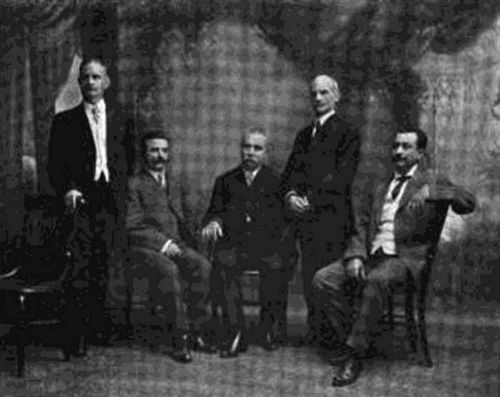
The board of directors in 1909
(José A. Muguerza, Mariano Hernández, V. Rivero y Gajá, Francisco G. Sada, José L. Garza)
|
In 1892 Rivero managed a branch of the Banco Nacional de México in Monterrey. Between 1892 and 1899 he was the promoter of two banks, the Banco Mercantil de Monterrey and the Banco de Nuevo León. He also participated in companies, such as the Compañía Minera Azteca and Compañía Minera Carbonato in the field of mining; in El Barco, in the Fábrica de Vidrios y Cristales de Monterrey and in the Compañía Industrial de Artefactos de Metal Laminado; in the Compañía Ferrocarriles Urbanos de Monterrey and in the Compañía de Tranvías de Oriente y Sur de Monterrey in the transport sector; and in the Compañía de Baños de Monterrey in the services sector. He was one of the directors of Cementos Hidalgo. S.A.Cementos Hidalgo S.A. was legally incorporated in Gómez Palacio, where Juan Brittingham resided, on 3 February 1906. It began operations in December 1907 in San Nicolás Hidalgo, about forty kilometres north of Monterrey. The plant was built in the vicinity of Monterrey due to the spectacular richness of the deposits detected in the mountains near Hidalgo. The list of shareholders and the board of directors reflected the combination of capital from Chihuahua, La Laguna, Monterrey and the city of Durango. Juan F. Brittingham, director-general of the Cia. Industrial Jabonera de la Laguna, and president of the Banco de la Laguna, was the Chairman of the first board of Directors; the illustrious landowner Pablo Martínez del Río vice-president; the Irish Francisco Belden treasurer, and Miguel Torres, a member of a vigorous industrial clan of Torreón and Gómez Palacio, secretary. Among the members were Luis Gurza, outstanding merchant and owner from Durango; Valentín Rivero y Gajá, an industrialist from Monterrey whose father, the Asturian Valentín Rivero, had been one of the great protagonists of the boom that the American Civil War produced; Gilberto Lavín, member of one of the longest-established farming families in La Laguna and manager of the Lavín cotton properties, Gomez Palacio; and the inevitable Chihuahuan Juan Terrazas. In 1908 its officers were Juan F. Brittingham, as president; Valentin Rivero y Gajá, as treasurer; Miguel Torres, manager of the Banco Minero at Gomez Palacio and the Banco de la Laguna, as secretary; Francisco Gómez Palacio, a capitalist from Durango, as auditor; Luis Garza, a capitalist from Durango; Juan Terrazas and Gilberto Lavín(The Mexican Herald, 16 January 1908). The initial manager was Alberto G. Cárdenas.. He was vice president of the bank in 1908 and signed some notes dated 6 March 1907. |
 |
|
Along with his brothers-in-law Francisco Sada and José Calderón and a nephew-in-law named Isaac Garza he formed the Cervecería Cuauhtémoc in 1890. Muguerza was a pioneer in the streetcar industry in Monterrey, participated as founder and director of the Banco Mercantil de Monterrey, in the Vidriera Monterrey, La Victoria constructions and materials company, , Cementos Mexicanos, the Compañía Fundidora de Fierro y Acero de Monterrey and Junta de la Unión Regional Nuevoleonesa. Perhaps his most significant business or project was when he and his family decided to enter health services. His eldest daughter fell ill, for which she was taken to the only private hospital in Monterrey called El Salvador. Since the hospital did not have an elevator, Muguerza had to carry her up to her room. So he decided to found a hospital with better facilities and it opened on 16 July 1934. Over the next decades, the Catholic, not-for-profit Muguerza Group added hospitals in Monterrey, Puebla, Chihuahua and Reynosa. He died in Monterrey on 14 March 1939 at the age of 80. He signed some notes dated 6 March 1907. |
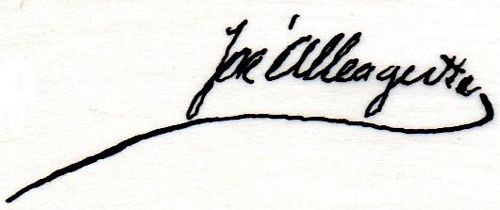 |
|
He signed some notes dated 6 March 1907. |
|
|
He was born in Monterrey on 12 December 1856, the son of Francisco Sada Gómez and María del Carmen Muguerza Crespo, the older sister of the investor José A. Muguerza. He studied in Monterrey and Matamoros, Tamaulipas, where he began his commercial activity as an employee of the importing business of Francisco Armendáriz. At the age of 22 he moved to Chihuahua where he began working for J. González Treviño Hermanos., a business that was decisive in the development of the Comarca Lagunera. In 1880 he settled in Saltillo, Coahuila, where in addition to his personal business, he looked after that of the Casa Calderón of Monterrey. In 1891 he was a founding partner in the Cervecería Cuauhtémoc and in August 1894 became its General Manager. As such he directed and coordinated the company with all his capacity and experience , laying the foundations for its industrial expansion. He was also a founding director of the Fundidora de Fierro y Acero de Monterrey La Fundidora de Fierro y Acero was organised on 5 May 1900 by Eugenio Kelly, of New York, Antonio Basagoiti and León Signoret, of Mexico City, and Vicente Ferrara of Monterrey. The first Consejo de Administración was composed of Directores Propietarios: Antonio Basagoiti, Isaac Garza, León Signoret, Vicente Ferrara, Adolfo Zambrano, Valentín Rivero y Gajá and Ernesto Madero; Directores Suplentes: Francisco G. Sada, Constantino de Tárnava, Enrique Gorostieta, Tomás Mendirichaga, M. Cantú Treviño, León Honnorat, Joaquín Maiz, Fernando Izaguirre and Miguel Ferrara; Comisarios Propietarios: Francisco Belden and Ildefonso Zambrano. Comisarios Suplentes: Francisco Armendaiz y José Negrete and of the Vidriera Monterrey. He died in Monterrey on 31 March 1945. He signed some notes dated 6 March 1907. |
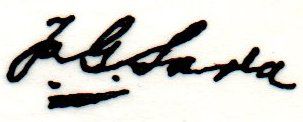 |
In December 1913 the bank closed their offices "temporarily" because of the exceptional demand for funds and the inability to bring any in because of the difficulties with communications. The gold and silver assets were moved to a branch specially set up in Laredo, Texas. This Oficina Provisional operated from February 1914 to 1916. (At the same time the branches of the Banco Nacional de México and Banco de Londres y México moved to the capital, taking their books and stocks with them).
The bank refused to produce its documents to Carranza's Comisión Reguladora e Inspectora de Instituciones de Crédito but the commission based its decision on the balance dated 31 December 1915, which showed that it did not comply with the Ley General, and so, on 8 March 1916, the commission nullified the bank's concession.
Somone who was a bank teller in Brownsville, Texas, from 1912 until his bank failed in 1929 reported that after the Mexican banks closed in 1916 the American banks, along the border at least, continued to honour Banco Nacional and Banco Mercantil de Monterrey notes for quite a lengthy time afterwards. Apparently the banks had built up quite healthy credits in American funds in various banks on the American side. The Brownsville banks forwarded the banknotes to Laredo for collection and continued to do this until the Laredo bank notified them that funds were finally exhaustedletter R. O. Bork, 10 September 1972.
Under Obregón's decree of 31 January 1921 the bank was placed into Class A (for banks whose assets were greater than their liabilities) and allowed to resume all customary operations except the issue of bank notes.

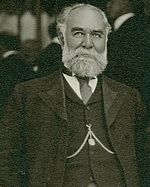
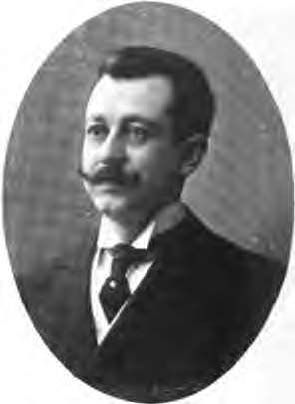 José L. Garza had many years of banking experience in Mexico and was connected with the bank from its formation, originally as auditor. He was appointed manager on 1 May 1906.
José L. Garza had many years of banking experience in Mexico and was connected with the bank from its formation, originally as auditor. He was appointed manager on 1 May 1906.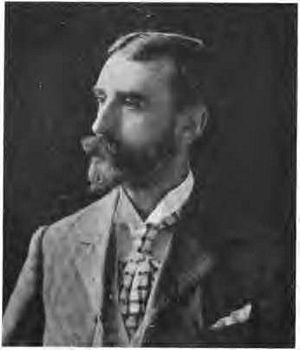
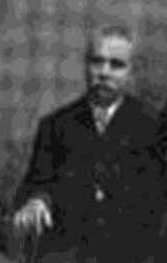

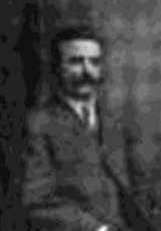 Mariano Hernández Mendirichaga (1869-1959) was the nephew of Tómas Mendirichaga Hernández. He married Mercedes Rivero Fernández, who was the daughter of
Mariano Hernández Mendirichaga (1869-1959) was the nephew of Tómas Mendirichaga Hernández. He married Mercedes Rivero Fernández, who was the daughter of 